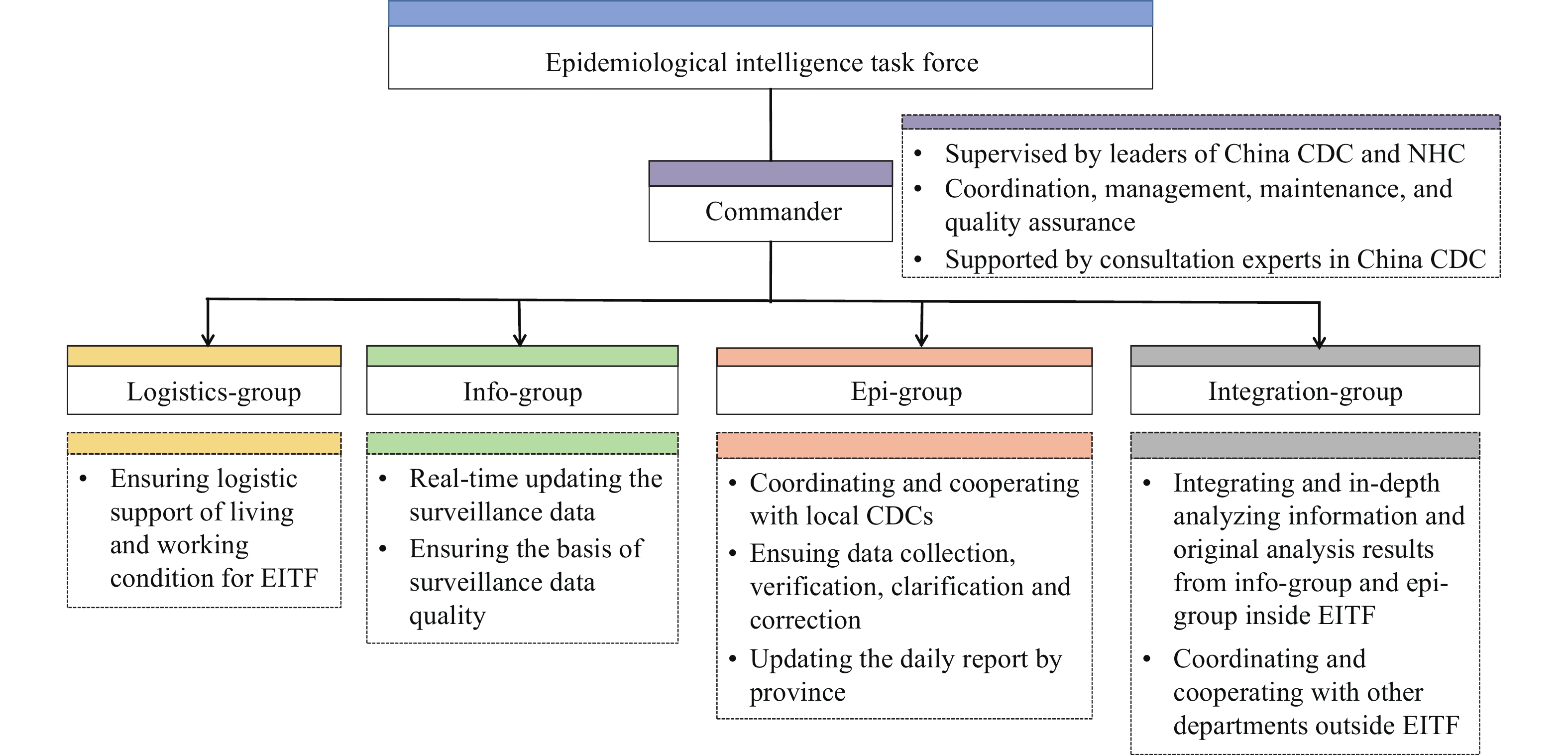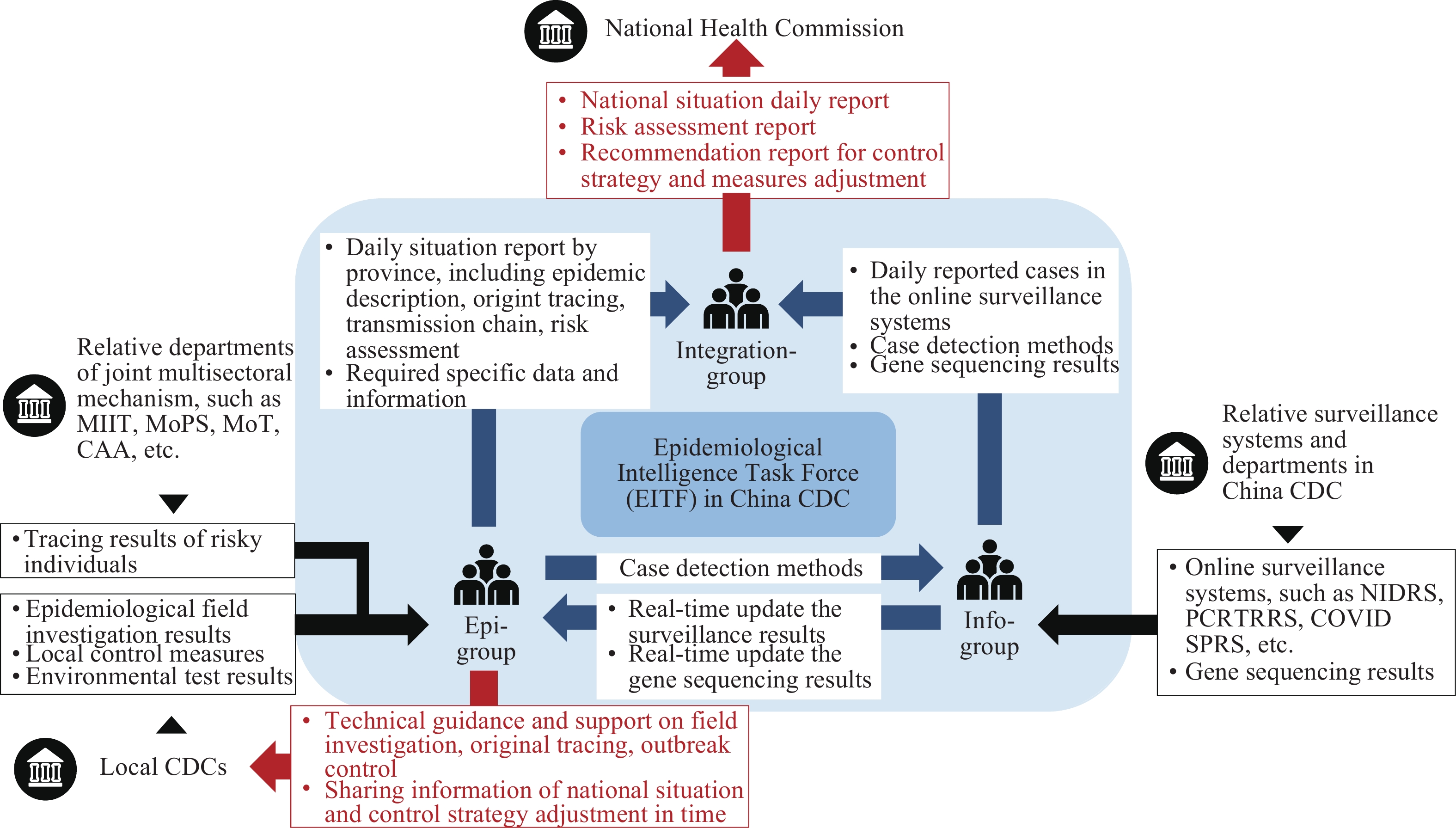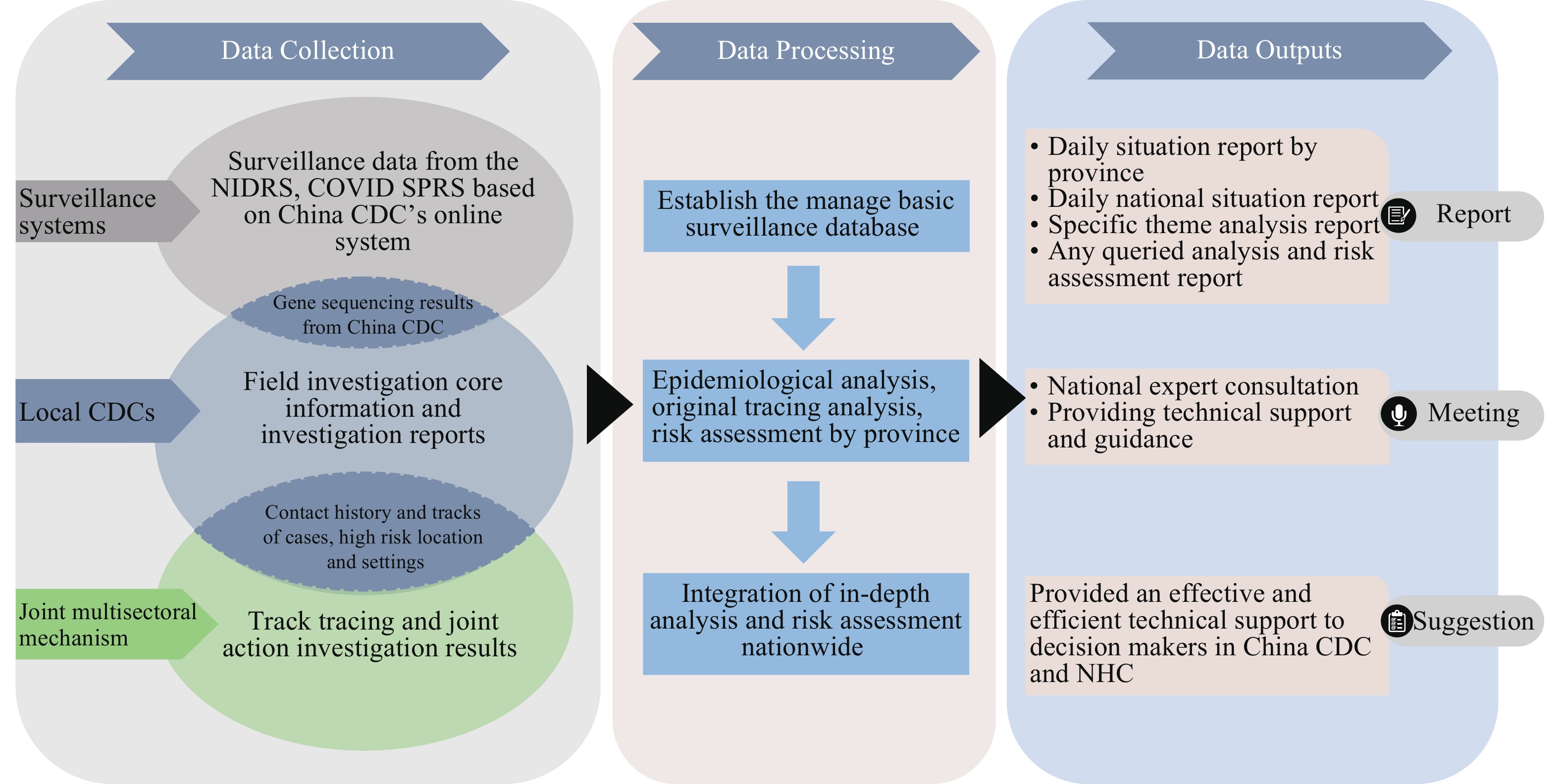-
The coronavirus disease 2019 (COVID-19) pandemic has been going on for nearly three years since the coronavirus outbreak were first reported (1-3). China managed to control the unexpected first wave in Wuhan city, Hubei Province by using strict suppression measures (4-5). Later, to prevent imported infections and control subsequent local transmission, China adjusted and implemented a proactive strategy widely known as the Dynamic COVID-Zero Strategy (6-7).
Chinese Center for Disease Control and Prevention (China CDC) has continuously played an important role in China’s fight against COVID-19 since 31 December 2019, when National Health Commission of the People’s Republic of China (NHC) sent a team of experts to Wuhan, Hubei Province to provide technical support for epidemic prevention and control decision making (8). To effectively support China’s proactive COVID-19 response strategies, including the general policy of preventing the coronavirus from re-entering the country and causing new epidemics, and the principles of early detection, early reporting, quarantine, and treatment (4), China CDC established an emergency response intelligence management framework for risk awareness and assessment. Since the April 2021, identification of the Delta variant of interest and its rapid emergence as the dominant severe acute respiratory syndrome coronavirus 2 (SARS-CoV-2) variant in the global pandemic, the number and magnitude of imported cases and subsequent domestic outbreaks in China have increased. When the Delta variant caused a large outbreak in July 2021 that originated in the international airport in Nanjing, Jiangsu Province and ultimately infected 1,162 people in 14 provincial-level administrative divisions (PLADs) across the country, there was an urgent need for China CDC to provide more efficient and accurate situational awareness, risk assessment, and timely technical recommendations (5). To improve the capacity, efficiency, and effectiveness of response to the Delta variant epidemic wave, a specific COVID-19 Epidemiological Intelligence Task Force (EITF) was established in China CDC in late July 2021. EITF was maintained, improved, and continuously upgraded through April 2022, and was expanded in response to a series of Omicron outbreaks from February to April 2022.
EITF is a successful, concrete model of an Emergency Operations Center (EOC) working during outbreak response and providing essential technical support for decision making — from integration of data collection and analysis, to situational awareness and assessment, and to making suggestions for resource deployment and strategy improvement. In this recollection, we describe and share the EITF framework and mechanisms with national and sub-national technical institutions with the aim of improving future preparedness and response.
-
The EITF mission is to provide effective and efficient technical support for national response to COVID-19 outbreaks. For this mission, the EITF must provide timely data collection & analysis and risk awareness & assessment, and propose timely emergency response actions to control outbreaks — for example, whether and where to deploy resources or whether an airplane or train should be monitored and passengers traced.
-
The EITF essential framework ensures regular operations and includes a commander, an info-group, an epi-group, an integration-group, and a logistics-group (Figure 1). The four EITF groups collaborate closely, in parallel, and under a unified lead by the commander. Each group has specific tasks according to their responsibilities and works toward the EITF mission. The commander is supervised by China CDC and NHC leadership and supported by expert consultants in China CDC. He or she is responsible for coordination, management, maintenance, and quality of all outputs, including reports, recommendations, and suggestions.
 Figure 1.
Figure 1.Framework and structure of EITF.
Note: Info denotes information. Epi denotes epidemiology.
Abbreviation: EITF=epidemiological intelligence task force; NHC=National Health Commission.
The info-group has a fundamental responsibility for surveillance data quality and is responsible for monitoring, collecting, cleaning, and managing surveillance data in the online national surveillance systems of China CDC (9-10), including the Notifiable Infectious Disease Reporting System (NIDRS) (10-11) and the COVID Screening Positive Reporting System (COVID SPRS).
The epi-group is fundamental to risk assessment, and is responsible for epidemiological field investigation findings and information collection, verification, clarification, and correction through coordination and cooperation with local CDC liaisons (Table 1). The epi-group is responsible for real-time analysis of case-patient descriptions, outbreak descriptions, original source of infection reports, and transmission chain descriptions, and is responsible for completing the daily analysis report of each PLAD.
Type of information Source of information Liaison group Time requirement Specific contents requirement Demographic and basic information of each PCR positive individual NIDRS, COVID SPRS Info-group Update in real-time Demographic information, illness onset information, sampling and testing information, date of admission and discharge, severity of illness, etc Field core information of each PCR positive individual Liaisons in local CDCs Epi-group Within 4 hours after report Case detection methods, exposure history by travelling or living in area with outbreaks, contact history of any positive individuals, etc Field investigation report of each PCR positive individual NIDRS, liaisons in local CDCs Epi-group Within 24 hours after report Detailed exposure history, potential sources of infection, risk assessment, control measures Gene sequencing analysis results National Institute of Viral Disease control and prevention (NIVD), China CDC Info-group Update in real-time Whole gene sequences, in comparison with the prior sequences in NIVD, GeneBank and GISAID Environmental test results Liaisons in local CDCs Epi-group Update
in real-timeNucleic acid test results of environmental samples collected from the living, working and visiting location and contacted items Nucleic acid screening results Liaisons in local CDCs Epi-group Update
in real-timeDate, location and number of sampling and testing when implementing nucleic acid screening each time Movement track tracing Liaisons in relative departments of joint multisectoral mechanism, such as MIIT, MoPS, MoT, CAA, etc Epi-group Update
in real-timeMobile phone signal movement, electronic payment records, monitoring video records, etc. within the past 14 days before illness onset or testing positive, and spatiotemporal relationship of different cases by analyzing the movement tracks Note: Info denotes information. Epi denotes epidemiology.
Abbreviation: EITF=epidemiological intelligence task force; NIDRS=notifiable infectious disease reporting system; COVID SPRS=coronavirus disease screening positive reporting system; PCR=polymerase chain reaction; GISAID=global initiative of sharing all influenza data; MIIT=the Ministry of Industry and Information Technology; MoPS=the Ministry of Public Security; MoT=the Ministry of Transportation; CAA=the Civil Aviation Administration.Table 1. Information requirements of EITF.
The integration-group is the core analytic group, and is responsible for integration and in-depth analysis of information, and original analyses from the EITF info-group and epi-group, occasionally combining with other COVID-19-relevant data and information outside of EITF, to complete risk assessment and recommendation reports for decision makers in China CDC and NHC.
The logistics-group is responsible for supporting living and working conditions to ensure normal operation of EITF and provides a strong foundation for the work of the other three groups and the entire EITF. Logistics-group duties include supporting working locations and environments, equipping computers and ensuring internet connectivity, providing safe dining conditions, and providing infection control and prevention measures as needed.
The size of the four groups was scaled according to epidemic situation and EITF needs — for example, EITF was expanded in March 2022 in response to Omicron outbreaks and Omicron’s more rapid transmission. To closely track changes in COVID-19 epidemic situations in one or more PLADs or areas, the epi-group usually required several small epi-teams. When EITF was established in July 2021, it included one commander, a 5-person info-group, a 10-person epi-group, a 5-person integration-group, and a 3-person logistics-group. The original 24-person EITF was able to deal with sporadic and small scale COVID-19 outbreaks occurring in no more than 10 PLADs simultaneously. However, to manage the COVID-19 resurgence and the more contagious Omicron importations into the mainland of China, in March 2022, EITF was expanded to 74 persons — the largest thus far — consisting of one commander, a 15-person info-group, a 57-person epi-group divided into 6 epi-teams, a 7-person integration-group, and a 4-person logistics-group.
-
The essence of EITF workflow is data and information streaming, which was developed into a cycle in EITF for highly efficient data sharing (Figure 2). For example, when an individual tested positive for SARS-CoV-2, he or she was firstly reported to COVID SPRS and subsequently to NIDRS. Info-group staff extracted data on all reported cases from COVID SPRS and NIDRS several times per day and shared the data extracts with the epi-group. When receiving data from the info-group, responsible epi-group staff contacted their provincial CDC liaisons to obtain core information and the field investigation case reports in a timely manner, completed or updated the daily report of the PLADs, and shared the up-to-date data with the integration-group the following morning. Normally, the integration-group summarized information from the info-group and the epi-group, updating the national situation report and providing summarized information to the commander every morning. In some emergencies, the integration-group or the commander would work directly with the info-group and the epi-group to complete an urgent analysis.
 Figure 2.
Figure 2.Workflow of EITF.
Note: Info denotes information. Epi denotes epidemiology.
Abbreviation: EITF=epidemiological intelligence task force; NIDRS=notifiable infectious disease reporting system; COVID SPRS=coronavirus disease screening positive reporting system; MIIT=the Ministry of Industry and Information Technology; MoPS=the Ministry of Public Security; MoT=the Ministry of Transportation; CAA=the Civil Aviation Administration.
EITF received seven types of data and information as essential input (Table 1) and produced three major types of regular outputs, including several types of reports, meetings with local CDCs, and recommendations to decision makers (Figure 3). Inputs and outputs were coordinated among the three major working groups in EITF — the info-group, the epi-group, and the integration-group.
 Figure 3.
Figure 3.Dataflow in EITF.
Abbreviation: EITF=epidemiological intelligence task force; NHC=National Health Commission; NIDRS=notifiable infectious disease reporting system; COVID SPRS=coronavirus disease screening positive reporting system.There were 5 mechanisms to ensure normal operation of EITF: 1) EITF could directly report to decision makers in China CDC and NHC; 2) an EITF liaison could directly coordinate and cooperate with liaisons of other departments, such as Ministry of Industry and Information Technology, Ministry of Public Security, Ministry of Transportation, Civil Aviation Administration, and State Administration of Railways under the National Joint Multisectoral Mechanism; 3) EITF could directly coordinate and cooperate with departments in NHC; 4) EITF liaisons could directly contact designated provincial liaisons in local CDCs for any needs on behalf of NHC; and 5) EITF could directly coordinate and cooperate with national working groups in the field that was deployed by NHC to affected PLADs.
-
In the past year, EITF has dealt with approximately 70 domestic outbreaks, collected and processed the information on more than 30,000 individuals who screened positive for COVID-19, raised approximately 4,000 alarms, coordinated over 180 joint multisectoral tracings, completed more than 1,500 technical reports, and held over 100 meetings with local CDCs and national working groups. For example, in Shandong Province, the local CDC and government urgently terminated unnecessary control measures against a train upon a decision based on an EITF risk assessment that indicated there was no risk of virus transmission or spread on the train because the individual was not infectious while on the train (12).
EITF outputs provided effective and efficient technical support to NHC and China’s COVID-19 response. For example, control measures — especially the at-risk population tracing measures — were strengthened and accelerated as needed, while the overly strict and ineffective tracing and management measures were stopped in a timely manner (13). Risk periods for virus spread and transmission were able to be pinpointed, especially when transmission was associated with crowded indoor places like restaurants, pubs, bars, cinemas, or public transportation.
-
Improving health emergency response capacity at all levels in a country, especially the essential epidemic intelligence capacity of receiving, verifying, analyzing, assessing, and investigating public health events, is crucial to ensure a timely and effective response to public health emergencies. The EOC has proved to be an important model for not only emergency response, but also health emergency coordination, management, and operation capacity building (14-15). Institutionalization and standardization are the fundamental bases of efficient and effective EOC operation.
Based on experience and lessons learned from previous responses, the World Health Organization (WHO) formulated a simple and unified emergency operation management framework — the Incident Management System (IMS) — for agencies at all levels, and developed an emergency response framework (ERF) to provide employees with basic guidelines for evaluation, classification, and response of public health emergencies (16). To further support and guide international health emergency responses, the WHO established the global public health emergency operation center network (EOC-net) in 2012 and released the public health EOC framework in 2015 to guide construction of EOCs globally (12,14-15).
Today, China CDC, with our EOC officially established in 2016, plays a role in command and coordination, resource integration, risk communication, and technical support for event response (15). China CDC has launched a first-level emergency response since January 2020, and as a part of the emergency response framework at that time, the predecessor of EITF was a surveillance and investigation team that had only 20 professional staff. Later, EITF was established to fulfill emergency response needs and exercised its core functions collocated with EOC.
Based on the EOC model, EITF has gradually standardized and institutionalized the position setting, manpower mobilization, personnel training, and working mechanisms by developing standard operating procedures (SOPs). During the past eight months, EITF achieved its mission effectively and efficiently by organically combining structure and function, including establishing dynamic groups of multi-disciplinary experts and professionals, a fully equipped venue, and a virtual platform for communication and coordination. EITF provided essential practices in China CDC’s EOC and serves as a replicable model EOC during COVID-19 and other health emergency response at all levels of China. A national EITF network with China CDC’s and provincial EITFs can be established, which will build epidemiological capacity and improve emergency response efficiency in China.
-
We thank all the staff of local CDCs for field investigations and data collection, and all members of the Epidemiological Intelligence Task Force in China CDC for data collection, analysis, assessment, and recommendations during these eight months. We also thank Wenqing Bai for preparing figures and tables for the manuscript.
-
No conflicts of interest.
HTML
Mission and Responsibilities
Essential Framework
Workflow and Mechanisms
Effectiveness and Efficiency
| Citation: |




 Download:
Download:




